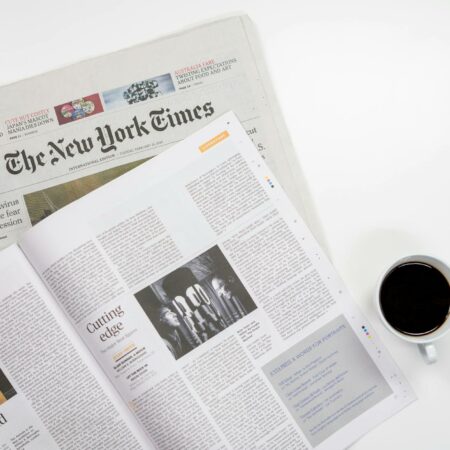We’ve discussed the importance of having images on your website, but imagery goes far beyond your website. Adding visual elements that support your message to your marketing efforts (both digital and print) always elevates your pieces. To take this a step further, you could work with a photographer to create one-of-a-kind images to use on your marketing materials.
By hiring a photographer, not only will you be able to use original images throughout your work, but they will be able to deliver a folder of “on-brand” images that follow your brand guidelines and can provide a cohesive look throughout all of your marketing.
If you are considering hiring a photographer for your marketing needs, here are some things you can expect and tips on how to make this experience the most rewarding for your business.
Come Up with a Realistic Budget
The most significant consideration of working with a photographer is the cost. We won’t lie; it’s an investment to work with a professional photographer, but we would argue that it is a worthwhile, sound investment for your business.
Depending on your location, the length of sessions, and how many sessions you need, photography rates range between $350-1,500 per session. Before you let the sticker shock sink in, consider these factors that go into the price:
- Consulting time/planning
- The photographer’s time during the shoot and travel time
- Photo editing
- Photographer printing and copyright rights
- On-set planning, if applicable (hair, makeup, models, wardrobe, location renting, etc.)
As a business owner yourself, it’s a good idea to better understand what factors are considered when photographers generate a quote for your needs. This may help play into your decision on what is a reasonable budget for a photographer.
Define a Rough Shot List
It’s never recommended to go into a photoshoot without a plan (especially because of your financial and time investment), and creating a rough shot list of inspiration would fill this need.
Think about the kind of photos that would highlight your services/products or what your “on-brand” images would capture. Ask yourself questions like:
- What is the goal of this photoshoot?
- How and where will these photos be used (website, social media, brochure, etc.)?
- What aesthetics does my brand need to show in this photoshoot?
- Are you looking for something more corporate-looking or more casual/lifestyle?
- Where can I look for inspiration for this photoshoot?
- If there are people in the photos, what should they be wearing? How should they look?
- What other elements do I need to consider (makeup, location, props, etc.)?
These questions will help guide you with a rough “mood board” for your photoshoot. You can create a lightbox in a stock photography website or even a Pinterest board of the kind of photos to capture.
You don’t have to create an extremely detailed list for this shoot, and your photographer can probably offer some additional insight to finalize it. As long as you go in with a general plan, you will be set up for a successful photoshoot.
Selecting a Photographer
Now that you know your budget and the kind of shots you want, it’s time to look at photographer portfolios.
A good place to start looking for photographers online is by Googling “professional photographers in (your city/state).” If you work with an agency on your marketing efforts, you can also see if they have any recommendations of local photographers.
While browsing their websites, take a look at their portfolio of work, and consider questions like:
- Do they have any examples of working with brands?
- Does their style of photography meet my brand aesthetics?
- Do they have details about their price range?
Once you’ve found a couple of photographers that check your boxes, reach out to them and ask them detailed questions about:
- Their process
- What to expect during a photoshoot
- What’s included in their price (do edited photos come with their quote, or are those priced out separately)
- Their availability
- Etc.
Something to keep in mind: a good photographer will want to collaborate with you and do what they can to create the best photos. Be open to their insight and ideas; they’ve been doing this long enough to know what works best.
Based on their responses, you should be able to find a professional photographer that’s a good fit for your brand.
It’s Photoshoot Time!
It’s the big day! You’ve probably had a few conversations with your photographer about the style of photos you’re looking for and the plan for photoshoot day, and now you’re ready to create these amazing images you’ve been envisioning.
On the day of the photoshoot, depending on how much prep work needs to be done before the shoot (makeup, set setup, etc.), you’ll want to make sure you have enough time to get everything ready to go before the photographer arrives (unless they mentioned that they would handle this part of the photoshoot).
Luckily, if you did enough planning and work before the day of the photoshoot, this day should be a breeze. Use your shot list as a guide to make you get everything you need during the shoot. A good photographer will keep track of this as well, but it might help you, too.
That’s a Wrap…Now What?
Once the photoshoot is complete, the photographer will go back to their studio to review the images and edit them. When they are ready for you to review the photos, they will most likely send you a link to an online photo gallery to take a look.
These photos will have some sort of photographer watermark on them (this is to prevent their work from being stolen, but they should also send you unwatermarked images to use after review). While reviewing them, keep in mind your original goals for this photoshoot and where you will want to use the photos on your website and marketing collateral.
After you’ve reviewed your gallery, you can now utilize a library of original photos for your marketing materials!
Working with a photographer for your marketing efforts can be a gratifying experience, and we’d argue that it will pay for itself over time. Keep these tips in mind when working with a photographer in the future.
To learn more about photography for marketing, let’s get in touch today.





